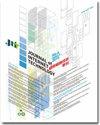基于结构信息检测的高分辨率SAR图像去斑点改进Fisher MAP滤波器
IF 1.2
4区 计算机科学
Q4 COMPUTER SCIENCE, INFORMATION SYSTEMS
引用次数: 4
摘要
Fisher分布是高分辨率(HR)合成孔径雷达(SAR)图像的一个流行模型,因为它具有高峰值和重尾的特性,以及它的理论合理性和数学可处理性。在对SAR图像进行Fisher建模的基础上,提出了最大后验滤波器。在Fisher模型中,图像外观的参数被认为是固定的,以对应于多外观强度图像的形成机制,另外两个参数是基于第二类统计从SAR图像中准确评估的。为了改进Fisher MAP滤波器,特别是在散斑抑制方面,利用点目标检测、自适应窗口方法、均匀区域检测和最均匀子窗口的选择,创建了基于结构信息识别的Fisher MAP滤波器。HR SAR图像的去斑点实验表明,基于结构信息检测的改进Fisher MAP滤波器可以抑制均匀和边缘区域的斑点,有效地保留精细的细节、边缘和点目标。本文章由计算机程序翻译,如有差异,请以英文原文为准。
Improved Fisher MAP Filter for Despeckling of High-Resolution SAR Images Based on Structural Information Detection
Fisher distribution is a popular model for high-resolution (HR) synthetic aperture radar (SAR) images due to its high-peaked and heavy-tailed characteristics as well as its theoretical justification and mathematical tractability. Based on the Fisher modeling of SAR images, the maximum a posteriori (MAP) filter is suggested. In the Fisher model, the parameter of image looks is thought to be fixed to correspond to the formation mechanism of multi-look intensity images, and the other two parameters are accur ately assessed from the SAR image based on second-kind statistics. To improve the Fisher MAP filter especially in the aspect of speckle suppression, the Fisher MAP filter based on recognition of structural information is created using point target detection, the adaptive windowing method, homogeneous region detection, and selection of most homogeneous sub-window. The experiments on despeckling of HR SAR images demonstrate that the improved Fisher MAP filter based on structural information detection can suppress speckle in homogenous and edge regions, and effectively preserve fine details, edges, and point targets.
求助全文
通过发布文献求助,成功后即可免费获取论文全文。
去求助
来源期刊

Journal of Internet Technology
COMPUTER SCIENCE, INFORMATION SYSTEMS-TELECOMMUNICATIONS
CiteScore
3.20
自引率
18.80%
发文量
112
审稿时长
13.8 months
期刊介绍:
The Journal of Internet Technology accepts original technical articles in all disciplines of Internet Technology & Applications. Manuscripts are submitted for review with the understanding that they have not been published elsewhere.
Topics of interest to JIT include but not limited to:
Broadband Networks
Electronic service systems (Internet, Intranet, Extranet, E-Commerce, E-Business)
Network Management
Network Operating System (NOS)
Intelligent systems engineering
Government or Staff Jobs Computerization
National Information Policy
Multimedia systems
Network Behavior Modeling
Wireless/Satellite Communication
Digital Library
Distance Learning
Internet/WWW Applications
Telecommunication Networks
Security in Networks and Systems
Cloud Computing
Internet of Things (IoT)
IPv6 related topics are especially welcome.
 求助内容:
求助内容: 应助结果提醒方式:
应助结果提醒方式:


